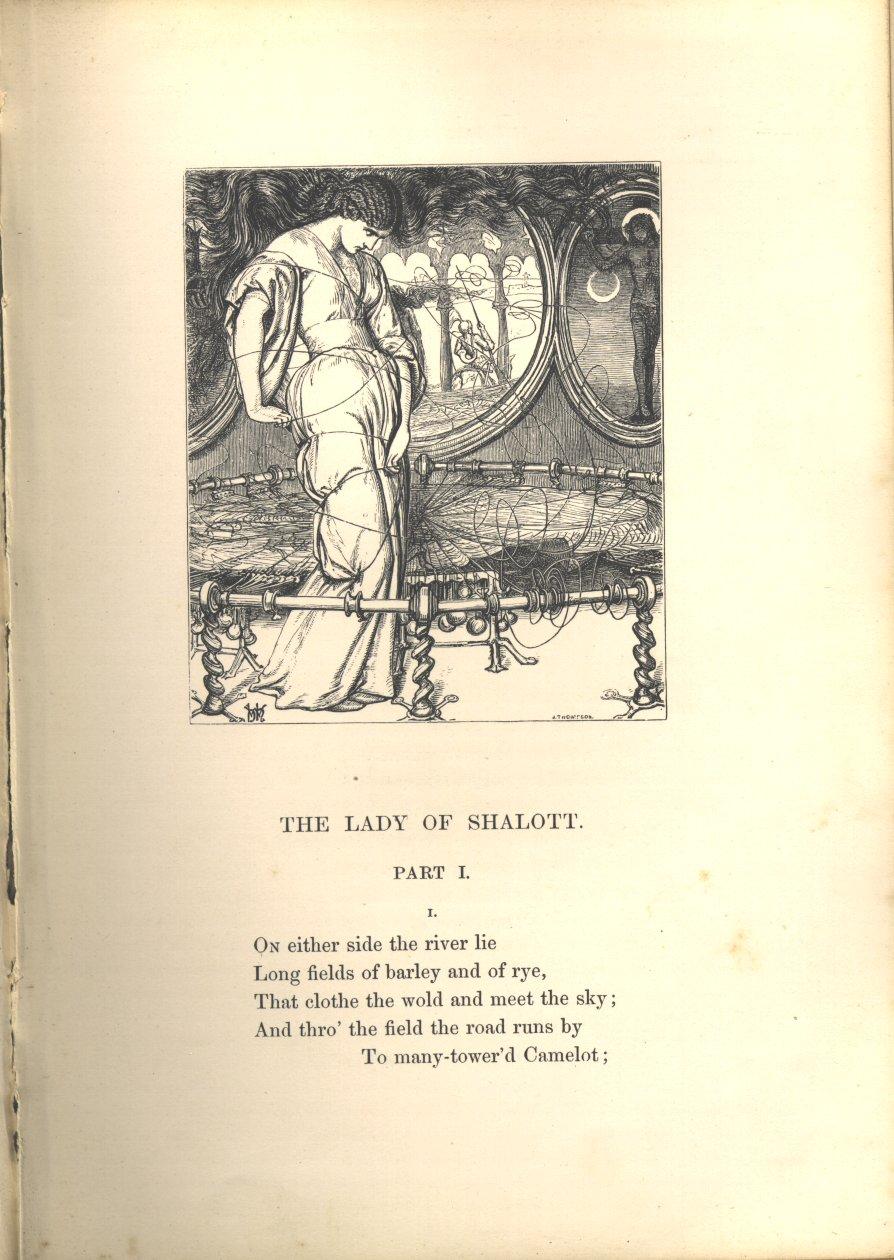William Holman Hunt was one of the prolific founding members of the Pre-Raphaelite Brotherhood artist group. His artwork is well-known for its careful attention to detail and brightly-coloured palettes, interwoven with Christian symbolism. His art piece, The Lady of Shalott, which was published in 1857 is no exception, featuring this characteristic religious subject matter. The 1857 illustration was first sketched out by Hunt and then etched into a wood-cut engraving by John Thompson, one of the most renowned wood-engravers of the time period. The engraving was then pressed onto paper through the use of a relief printing system. The lavishness of many of the wood-engravings within the edition, including this masterful piece by Hunt, is credited with having grown momentum for the wood-engraving movement in the United Kingdom. This wood-engraving illustration was published in Moxon’s edition of Alfred Tennyson’s Poems, a visually-illustrated poetry book. The illustrations featured inside included those from the other Pre-Raphaelite Brotherhood members, such as Dante Gabriel Rossetti and John Everett Millais. Hunt’s contribution depicted the Lady of Shalott tangled in her loom at the crucial moment where her curse comes upon her in the third part of the poem. The piece portrays the namesake Lady as gigantic in form and ensnared by the strands with her hair depicted wildly flailing around. On the Lady’s right-hand-side, a roundel is featured on the wall of her tower as a compositional element, portraying the crucifixion of Christ. This element was in stark contrast to the Arthurian origins of the original poem. Notably, Tennyson questioned this departure from his textual description in the poem, creating a tense relationship between Hunt and Tennyson. Though there are many distinct artistic revisions done by Hunt, such as the idea that the Lady’s tapestry unfurled around her, another notable revision is the use of Christian theology within the illustration. Many of Hunt’s other art pieces have featured the inclusion of such elaborate religious symbolism. Later on, Hunt painted a larger version of this illustration as an oil-painting circa 1880-1905. This version featured roundels that displayed a detailed depiction of nativity scenes and figures with Christ-like halos.
Sources:
Forward, Stephanie. “An Introduction to 'The Lady of Shalott'.” The British Library, 7 Apr. 2014, www.bl.uk/romantics-and-victorians/articles/an-introduction-to-the-lady-of-shalott.
Inglis, Alison, and Cecilia O'Brien. “'The Breaking of the Web': William Holman Hunt's Two Early Versions of The Lady of Shalott.” NGV, National Gallery of Victoria, June 2014, www.ngv.vic.gov.au/essay/the-breaking-of-the-web-william-holman-hunts-two-early-versions-of-the-lady-of-shallot/.
Janzen Kooistra, Lorraine. “The Moxon Tennyson as Textual Event: 1857, Wood Engraving, and Visual Culture.” BRANCH, Jan. 2013, www.branchcollective.org/?ps_articles=lorraine-janzen-kooistra-the-moxon-tennyson-as-textual-event-1857-wood-engraving-and-visual-culture.
Jeffers, Thomas L. "Tennyson's Lady of Shalott and Pre-Raphaelite Renderings: Statement and Counter-Statement." Nineteenth-Century Literature Criticism, edited by Kathy D. Darrow, vol. 196, Gale, 2008. Gale Literature Resource Center, https://link.gale.com/apps/doc/H1420082563/LitRC?u=rpu_main&sid=LitRC&xid=99c5a4f4. Originally published in Religion and the Arts, vol. 6, no. 3, 2002, pp. 231-256.
Read, Benedict. "George P. Landow, William Holman Hunt and Typological Symbolism: New Haven and London, Yale University Press for the Paul Mellon Centre for Studies in British Art, 1979. Pp. Xv + 192; 88 Ills. $25." Art Journal (New York. 1960), vol. 39, no. 4, 1980, pp. 308-313.


